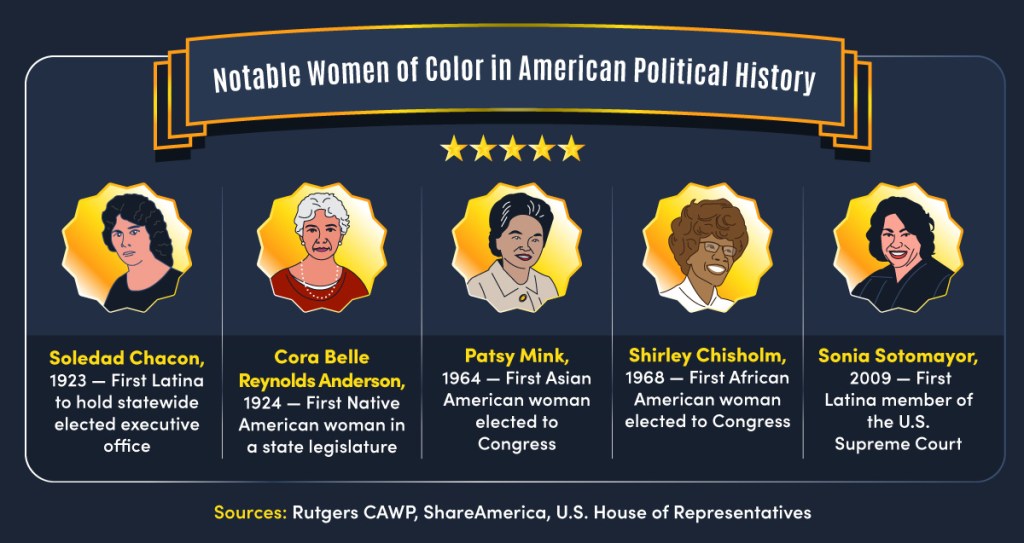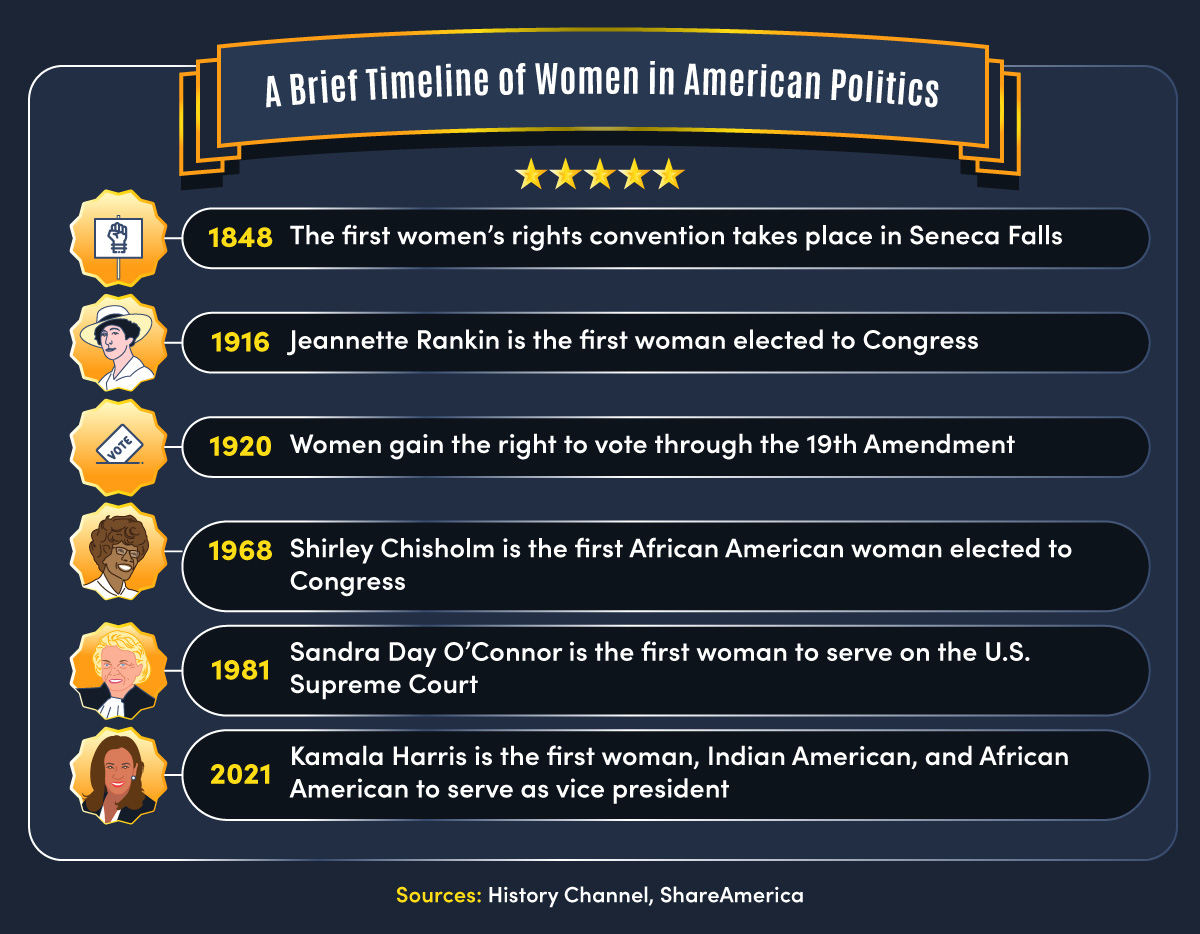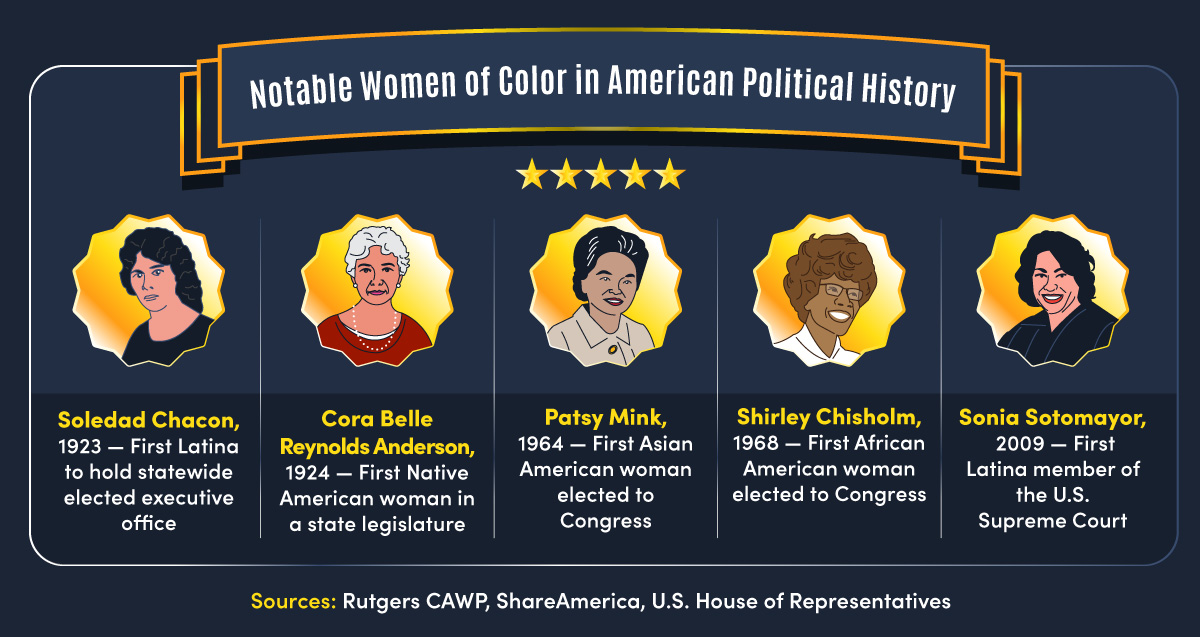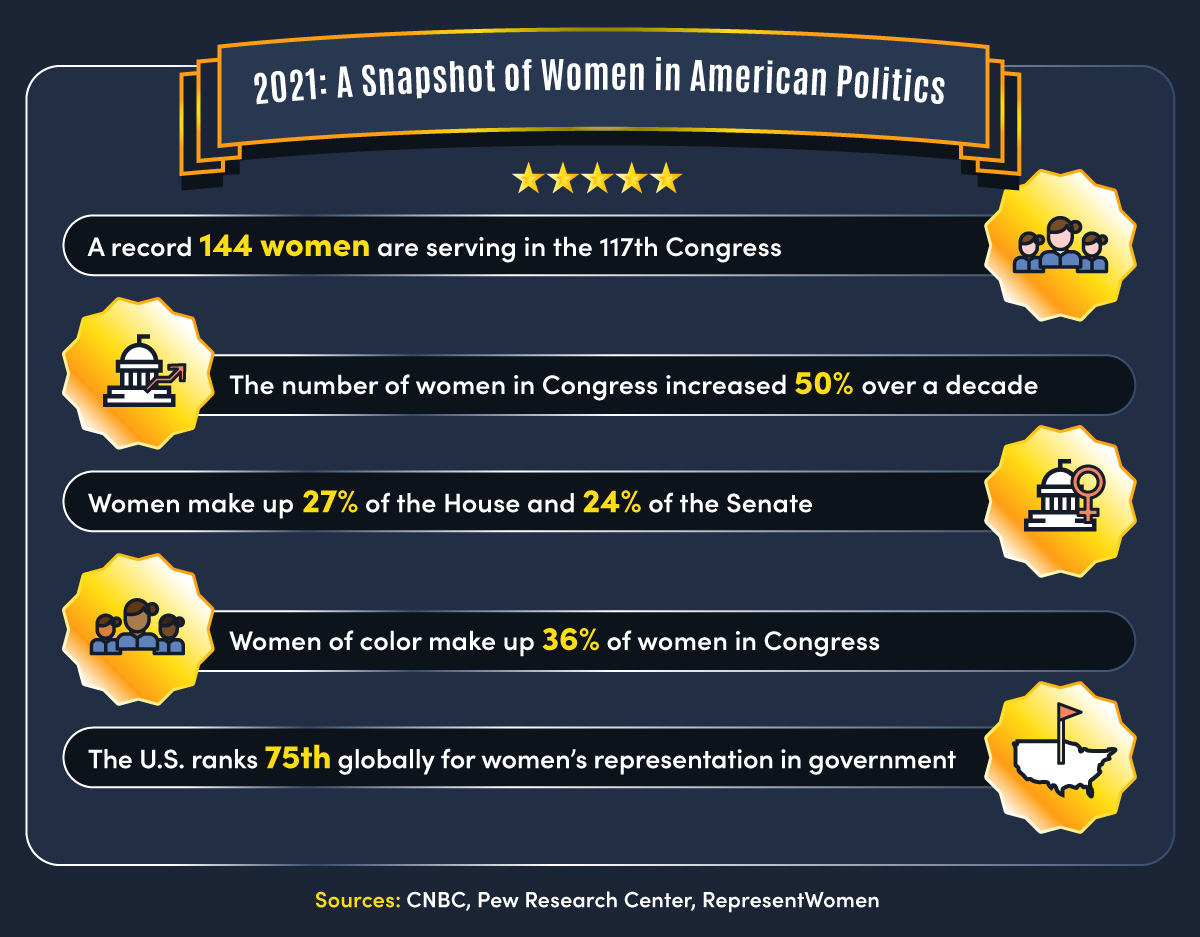Notable Women in American Politics: Achievements, Evolution, and Impact

Tables of Contents
A record number of 142 women are serving in Congress in 2021 following a landmark election that saw more women, including women of color, running for office than ever before. Still, women make up just a quarter of Congress, while comprising more than half the U.S. population.
Throughout U.S. history, women have played an important and evolving role in the political landscape — from Abigail Adams urging the Founding Fathers to “remember the ladies” in 1776 to this year, when Kamala Harris became the first woman and woman of color to take office as vice president.
Despite barriers to entry, women in American politics continue to break into new government roles, using their knowledge and experience to shape the nation’s laws, policies, and organizations. As American politics continue to evolve and new resources emerge to support diverse contributors, great potential exists to expand women’s involvement in government.
A history of women in American politics
The history of women in American politics is rich and varied. As the nation grew, women’s roles in government and political movements evolved as well, though it wasn’t always easy. Women have been actively excluded from the political landscape for centuries, often having to fight or even inherit their way into a government role.
The term “widow’s succession,” for example, was coined to describe the most common way for women to enter Congress well into the 1970s: by being elected or appointed to take the place of a deceased male relative. In 1922, Winnifred Mason Huck was elected to finish her late father’s term as a representative in Illinois. In 1973, Lindy Boggs took over her husband’s seat as a Louisiana representative after he was presumed dead in a plane crash; she kept her position for over 18 years.
Below are some notable dates and events for women in American politics:
- 1776: Abigail Adams wrote a letter to her husband John Adams asking that the Continental Congress “remember the ladies and be more generous and favorable to them than your ancestors. Do not put such unlimited power into the hands of the husbands.” Adams went on to become a politically active and outspoken first lady to the second president of the U.S. Even after her husband left office, Adams continued communicating with political leaders such as James Madison and Thomas Jefferson and speaking out about women’s issues.
- 1848: The Seneca Falls Convention launched the women’s suffrage movement. One-third of the 300 attendees signed the Declaration of Sentiments, modeled after the Declaration of Independence, which outlined women’s demands as U.S. citizens.
- 1869: Susan B. Anthony and Elizabeth Cady Stanton founded the National Woman Suffrage Association in an effort to fight for women’s rights, including the right to vote.
- 1869: Julia C. Addington became the superintendent of schools in Mitchell County, Iowa, likely making her the first woman elected to public office in the U.S.
- 1887: Susanna Madora Salter of Argonia, Kansas, became the first woman to serve as mayor of a U.S. city. A group of men put Salter’s name on the ballot as a practical joke, assuming she would lose and put the women’s political movement to shame. Salter ended up winning more than 60% of the votes cast, and served a single term with great conviction.
- 1892: Laura Eisenhuth became the first woman elected to any statewide executive office when she won her seat as superintendent of public construction in North Dakota.
- 1916: Jeanette Rankin, a representative from Montana, became the first woman elected to Congress. She famously said, “I may be the first woman member of Congress, but I won’t be the last.”
- 1920: Passage of the 19th Amendment to the U.S. Constitution granted women the right to vote.
- 1925: Nellie Tayloe Ross of Wyoming became the first female governor, replacing her late husband. She went on to be the vice chair of the Democratic National Committee.
- 1933: Frances Perkins became the first woman to serve in a Cabinet position, having been appointed secretary of labor by President Franklin Delano Roosevelt. Perkins was instrumental in writing the New Deal, which included landmark programs to restore the economy and increase jobs.
- 1981: Sandra Day O’Connor became the first woman to serve as a U.S. Supreme Court associate justice, a position she held for 24 years.
- 1984: Geraldine Ferraro, a representative from New York, became the first woman to be chosen as a vice presidential nominee by a major political party. She ran alongside Democratic presidential nominee Walter Mondale.
- 1992: Nicknamed the “Year of the Woman,” 1992 marked the first time more than two women served in the Senate simultaneously. By the end of the year, another four women had been elected.
- 1997: Madeleine Albright became the first female secretary of state, the highest ranking role for a woman in U.S. politics to that date.
- 2007: Nancy Pelosi, a representative from California, became the first female speaker of the house, a role she would retake in 2019.
- 2016: Hillary Clinton became the first woman to run for president as the nominee of a major political party.
- 2021: Kamala Harris, a senator from California, became the first woman, Indian American, and African American to serve as vice president. After winning the election in 2020, she said, “While I may be the first woman in this office, I will not be the last,” echoing Rankin’s 1916 quote.

These six events marked key steps in the advancement of women’s role in American politics, according to the History Channel and ShareAmerica. In 1848, the first women’s rights convention took place in Seneca Falls. In 1916, Jeannette Rankin was the first woman elected to Congress. In 1920, women gained the right to vote through the 19th Amendment. In 1968, Shirley Chisholm was the first African American woman elected to Congress. In 1981, Sandra Day O’Connor was the first woman to serve on the U.S. Supreme Court. In 2021, Kamala Harris was the first woman, Indian American, and African American to serve as vice president.
Resources for women’s history in American politics
The following links provide helpful information for learning more about women’s role in politics throughout American history:
- History.com, “Women in Politics”: This video highlights the groundbreaking contributions of many women in American politics, including Sandra Day O’Connor, Shirley Chisholm, and Madeleine Albright.
- History, Art & Archives United States House of Representatives, “Women on the Campaign Trail”: This is a discussion of how the cost of running for Congress has impacted women’s ability to campaign and the rise of groups such as Emily’s List to promote female candidates.
- New York Historical Society Museum & Library, “A Brief History of Women Running for Political Office”: As part of its Women at the Center program, the New York Historical Society celebrates women who ran for national office and worked to help create gender parity in the U.S. government.
- ShareAmerica, “Women in Politics: A Timeline”: This retrospective commemorates the political milestones of many U.S. women in politics.
- Time, “50 Women Who Made American Political History”: In honor of Women’s History Month, Time features 50 women who held influential roles in U.S. government.
African American women in politics
African American women in politics have made great strides to advance the causes of human rights, racial justice, and diverse representation despite the barriers inherent in a country based on slavery where systemic racism has persisted. Even the National American Woman Suffrage Association was predominantly white, excluding African American suffragists from its efforts and engaging in segregationist practices.
These are just some of the most notable names and accomplishments of African American women in American politics:
Sojourner Truth
A former slave, Sojourner Truth became a leader of the abolitionist and women’s rights movements. In 1851, she attended the Women’s Rights Convention in Ohio and delivered her famous speech, “Ain’t I a Woman?”
She said: “And ain’t I a woman? Look at me! Look at my arm! I have ploughed and planted, and gathered into barns, and no man could head me! . . . And ain’t I a woman? I have borne 13 children, and seen most all sold off to slavery, and when I cried out with my mother’s grief, none but Jesus heard me! And ain’t I a woman?”
Mary Church Terrell
Mary Church Terrell was the first president of the National Association of Colored Women (NACW), founded in 1896. Using the motto “Lifting as We Climb,” the NACW was created to advance the rights of African American women and break down barriers to voting for the African American community as a whole.
She went on to become the first African American member of the American Association of University Women in 1948. She continued to protest segregation and fight for civil rights throughout the U.S.
Shirley Chisholm
In 1968, Shirley Chisholm of New York became the first African American woman elected to Congress, going on to serve seven terms. In 1972, Chisholm became the first woman and African American to vie for a presidential nomination from a major party. Known as “Fighting Shirley,” she also co-founded the National Women’s Political Caucus in 1971.
Patricia Roberts Harris
In 1977, Patricia Roberts Harris became the first African American woman to serve in a Cabinet position when she was appointed secretary of housing and urban development by President Jimmy Carter. She went on to serve as secretary of health, education, and welfare in 1979.
After assuming her first Cabinet role, dissenters criticized her for her former position as a corporate lawyer, questioning her ability to understand and represent the needs of the poor. She told them, “I am a Black woman, the daughter of a dining car worker. I am a Black woman who even eight years ago could not buy a house in parts of the District of Columbia. I didn’t start out as a member of a prestigious law firm, but as a woman who needed a scholarship to go to school. If you think I have forgotten that, you are wrong.”
Carol Moseley Braun
In 1992, Carol Moseley Braun of Illinois became the first African American woman elected to the Senate, where she advocated for issues such as women’s rights, racial justice, and diverse representation. She fought to fund historic preservation of Underground Railroad sites and to stop the usage of the Confederate flag in designs for the United Daughters of the Confederacy.
When Moseley Braun was sworn into office in 1993, she said, “I cannot escape the fact that I come to the Senate as a symbol of hope and change. Nor would I want to, because my presence in and of itself will change the U.S. Senate.”
Condoleezza Rice
In 2001, Condoleezza Rice became the first African American woman to serve as national security advisor after being appointed by President George W. Bush. In 2005, she became the first African American woman to serve as secretary of state. She worked to promote peace talks and reform international policies across the globe, particularly in the Middle East.
Resources for African American women in politics
These links provide more information about the role of African American women in politics and how to support their inclusion in U.S. government:
- Black Girls Vote: This nonprofit organization empowers African American girls to make their voices heard in politics, combat racial bias, and represent their communities in the voting process.
- Black Women Organized for Political Action (BWOPA): Nonprofit organization BWOPA was founded in 1968 to educate African American women about the political process and motivate them to become involved through membership and community leadership opportunities.
- Higher Heights for America PAC: This political action committee is dedicated to supporting progressive African American women who run for political office and creating a Congress with diverse representation.
- National Park Service, “Between Two Worlds: Black Women and the Fight for Voting Rights”: This is an exploration of the pivotal role African American women played in helping to pass the 15th and 19th Amendments for voting rights.
- National Women’s History Museum, National Association of Colored Women: NWHM shares the history of African American women’s participation in the women’s rights movements, including the contributions of Sojourner Truth and Harriet Tubman.

These five women of color achieved important milestones in U.S. politics, as reported by Rutgers CAWP, ShareAmerica, and the U.S. House of Representatives. Soledad Chacon, 1923: First Latina to hold statewide elected executive office. Cora Belle Reynolds Anderson, 1924: First Native American woman in a state legislature. Patsy Mink, 1964: First Asian American woman elected to Congress. Shirley Chisholm, 1968: First African American woman elected to Congress. Sonia Sotomayor, 2009: First Latina member of the U.S. Supreme Court.
Other women of color in politics
Women of color in politics, including Latinas, Asian Americans, Pacific Islanders, and Native Americans, have made a significant impact as elected officials, community leaders, and revolutionaries.
Below are notable women of color in politics and their achievements:
- Soledad C. Chacó In 1923, Chacón was elected secretary of state of New Mexico, making her the first Latina to hold statewide elected executive office. She also filled in as acting governor of New Mexico, serving as the second female governor in U.S. history for one month in 1924 when Governor James F. Hinkle traveled to the Democratic National Convention in New York.
- Cora Reynolds Anderson. In 1925, Anderson of Michigan became the first Native American woman in a state legislature. A member of the Ojibwa tribe, she spent her political career championing public health and welfare.
- Patsy Mink. In 1964, Mink became the first Asian American woman elected to Congress, representing Hawaii for over 20 years.
- Ileana Ros-Lehtinen. In 1989, Ros-Lehtinen of Florida became the first Latina woman elected to Congress.
- Elaine Chao. In 2001, Chao became the first Asian American woman appointed to a Cabinet position when President George W. Bush invited her to be secretary of labor. Chao held the position for eight years, working for unions’ rights and workers’ safety. Chao was appointed U.S. transportation secretary by President Donald Trump in 2016; she resigned in 2021 after the riot at the Capitol, stating that she was “deeply troubled” by the conflict and Trump’s response.
- Sonia Sotomayor. In 2009, Sotomayor was appointed by President Barack Obama to become the first Latina to serve as an associate justice of the U.S. Supreme Court.
- Nikki Haley. In 2017, Haley became the first Indian American to serve in a Cabinet position. President Trump appointed her U.S. ambassador to the United Nations following her role as the first female governor of South Carolina.

Data from CNBC, the Pew Research Center, and RepresentWomen report that a record 144 women are serving in the 117th Congress; the number of women in Congress increased 50% over a decade; women make up 27% of the House and 24% of the Senate; women of color make up 36% of women in Congress; and the U.S. ranks 75th globally for women’s representation in government.
How women politicians continue to shape American politics
Women’s roles in American politics are evolving, opening new opportunities for women politicians to be decision-makers and policy changers. The number of women in Congress increased 50% over the last decade, with women now making up 27% of the House of Representatives and 24% of the Senate. Women of color now make up 36% of women in Congress. Women also make up over 30% of U.S. state legislators, a nearly seven times increase from 1971; 25.5% of them are women of color.
Still, we have a long way to go in creating equal representation. Despite these gains, the U.S. ranks 75th out of 193 countries globally for women’s representation in government. A lot of room exists for women to increase their participation in politics and become leaders and mentors for other women entering the field.
Resources for women in American politics
Women interested in building careers in government can access a range of resources to help them succeed in what is still a male-dominated and largely white field. Through these resources, they can learn more about their country’s political history, overcome obstacles to entry, network with colleagues, receive mentorship, and gather support.
Future women in American politics can consider these helpful resources:
- Council on Foreign Relations, Women’s Power Index: The Women and Foreign Policy program created this index to rank 193 United Nations member states in their efforts toward gender parity in politics.
- National Democratic Institute, Gender, Women and Democracy: This nonprofit organization helps women overcome individual, social, and institutional barriers to participating in politics.
- Running Start: This nonpartisan nonprofit trains women to run for public office and become community leaders with over 100 programs across the country.
- ShePersisted: This global initiative battles disinformation about women in politics by providing educational resources, research, and programs for support.
- UNWomen.org: This United Nations organization is dedicated to championing women and girls worldwide and empowering them to lead in government, develop financial security and autonomy, and set new benchmarks for equality.
The future of women in American politics
Women continue to become involved in American politics and create lasting change through their work, building on this complex and varied history. In the past few years alone, women and women of color have made an impact by running for Congress in record numbers and now hold more seats than ever before. The future of women in American politics depends on these efforts and increased action from current representatives and constituents in supporting women for U.S. government positions.
Infographic Sources
CNBC, “Despite Gains, the US Ranks 75th Globally in Women’s Representation in Government”
History, Art & Archives United States House of Representatives, “Women in Congress Historical Data”
History.com, “Women’s History Milestones: A Timeline”
Pew Research Center, “A Record Number of Women Are Serving in the 117th Congress”
RepresentWomen, “By the Numbers”
Rutgers Center for American Women and Politics, “Milestones for Women in American Politics”

